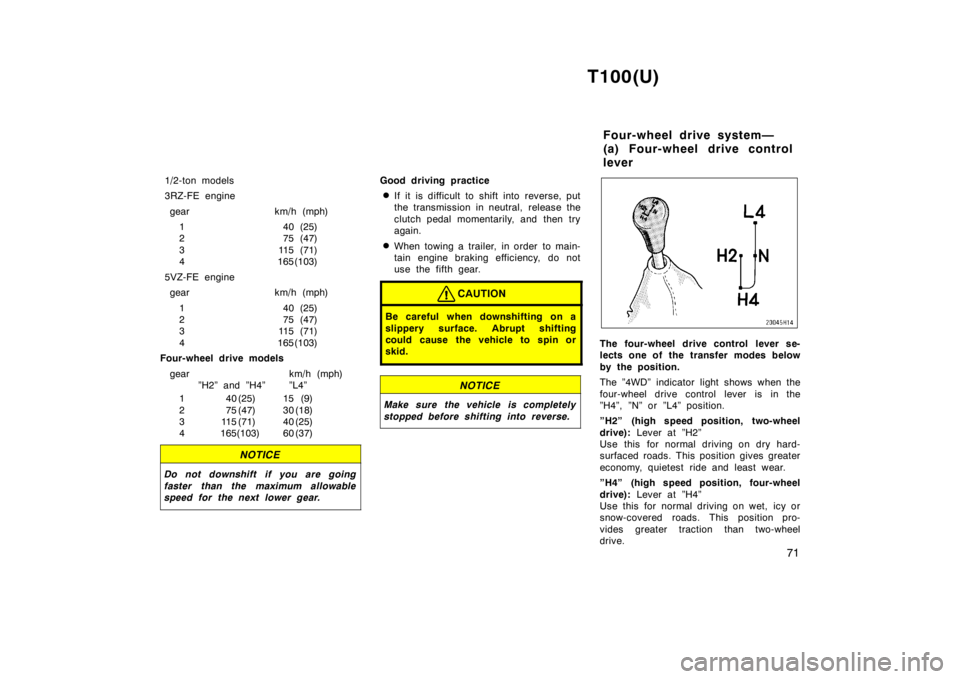traction control TOYOTA T100 1998 Owners Manual
[x] Cancel search | Manufacturer: TOYOTA, Model Year: 1998, Model line: T100, Model: TOYOTA T100 1998Pages: 214, PDF Size: 4.72 MB
Page 71 of 214

T100(U)71
1/2-ton models
3RZ-FE engine
gear km/h (mph) 1 40 (25)
2 75 (47)
3 115 (71)
4 165(103)
5VZ-FE engine gear km/h (mph)
1 40 (25)
2 75 (47)
3 115 (71)
4 165(103)
Four-wheel drive models
gear km/h (mph) ”H2” and ”H4” ”L4”
1 40 (25) 15 (9)
2 75 (47) 30 (18)
3 115 (71) 40 (25)
4 165(103) 60 (37)
NOTICE
Do not downshift if you are going
faster than the maximum allowable
speed for the next lower gear.
Good driving practice
� If it is difficult to shift into reverse, put
the transmission in neutral, release the
clutch pedal momentarily, and then try
again.
� When towing a trailer, in order to main-
tain engine braking efficiency, do not
use the fifth gear.
CAUTION
Be careful when downshifting on a
slippery surface. Abrupt shifting
could cause the vehicle to spin or
skid.
NOTICE
Make sure the vehicle is completely
stopped before shifting into reverse.
The four-wheel drive control lever se-
lects one of the transfer modes below
by the position.
The ”4WD” indicator light shows when the
four-wheel drive control lever is in the
”H4”, ”N” or ”L4” position.
”H2” (high speed position, two-wheel
drive): Lever at ”H2”
Use this for normal driving on dry hard-
surfaced roads. This position gives greater
economy, quietest ride and least wear.
”H4” (high speed position, four-wheel
drive): Lever at ”H4”
Use this for normal driving on wet, icy or
snow-covered roads. This position pro-
vides greater traction than two-wheel
drive. Four-wheel drive system—
(a) Four-wheel drive controllever
Page 185 of 214

T100(U)185
Rotating tires
To equalize tire wear and help extend
tire life, Toyota recommends that you
rotate your tires approximately every
12000 km (7500 miles). However, the
most appropriate timing for tire rotation
may vary according to your driving hab-
its and road surface conditions.
See ”If you have a flat tire” in Part 4 for
tire change procedure.
When rotating tires, check for uneven
wear and damage. Abnormal wear is usu-
ally caused by incorrect tire pressure, im-
proper wheel alignment, out-of-balance
wheels, or severe braking.
Installing snow tires and chains
WHEN TO USE SNOW TIRES OR
CHAINS
Snow tires or chains are recommended
when driving on snow or ice.
On wet or dry roads, conventional tires
provide better traction than snow tires.
SNOW TIRE SELECTION
If you need snow tires, select the same
size, construction and load capacity as
the original tires on your Toyota.
Do not use tires other than those men-
tioned above. Do not install studded tires
without first checking local regulations for
possible restrictions.
SNOW TIRE INSTALLATION
Snow tires should be installed on all
wheels.
Installing snow tires on the rear wheels
only can lead to an excessive difference
in road grip capability between the front
and rear tires which could cause loss of
vehicle control.
When storing removed tires, you should
store them in a cool dry place.
Mark the direction of rotation and be sure
to install them in the same direction when
replacing.
Page 210 of 214

T100(U)
210
This information has been prepared in ac-
cordance with regulations issued by the
National Highway Traffic Safety Adminis-
tration of the U.S. Department of Trans-
portation. It provides the purchasers and/
or prospective purchasers of Toyota
vehicles with information on uniform tire
quality grading.
Your Toyota dealer will help answer any
questions you may have as you read this
information.
DOT quality grades—All passenger ve-
hicle tires must conform to Federal
Safety Requirements in addition to
these grades. These quality grades are
molded on the sidewall.
Treadwear—
The treadwear grade is a
comparative rating based on the wear rate
of the tire when tested under controlled
conditions on a specified government test
course. For example, a tire graded 150
would wear one and a half (1-1/2) times
as well on the government course as a
tire graded 100. The relative performance
of tires depends upon the actual condi-
tions of their use, however, and may de-
part significantly from the norm due to
variations in driving habits, service prac-
tices and differences in road characteris-
tics and climate. Traction A, B, C—
The traction grades,
from highest to lowest, are A, B, and C,
and they represent the tire’s ability to stop
on wet pavement as measured under con-
trolled conditions on specified government
test surfaces of asphalt and concrete. A
tire marked C may have poor traction per-
formance.Warning: The traction grade as-
signed to this tire is based on braking
(straight ahead) traction tests and does
not include cornering (turning) traction.
Temperature A, B, C— The temperature
grades are A (the highest), B, and C,
representing the tire’s resistance to the
generation of heat and its ability to dissi-
pate heat when tested under controlled
conditions on a specified indoor laboratory
test wheel. Sustained high temperature
can cause the material of the tire to de-
generate and reduce tire life, and exces-
sive temperature can lead to sudden tire
failure. The grade C corresponds to a lev-
el of performance which all passenger car
tires must meet under the Federal Motor
Vehicle Safety Standard No.109. Grades B
and A represent higher levels of perfor-
mance on the laboratory test wheel than
the minimum required by law. Warning: The temperature grades for this
tire are established for a tire that is prop-
erly inflated and not overloaded. Exces-
sive speed, underinflation, or excessive
loading, either separately or in combina-
tion, can cause heat buildup and possible
tire failure.
Uniform tire quality grading